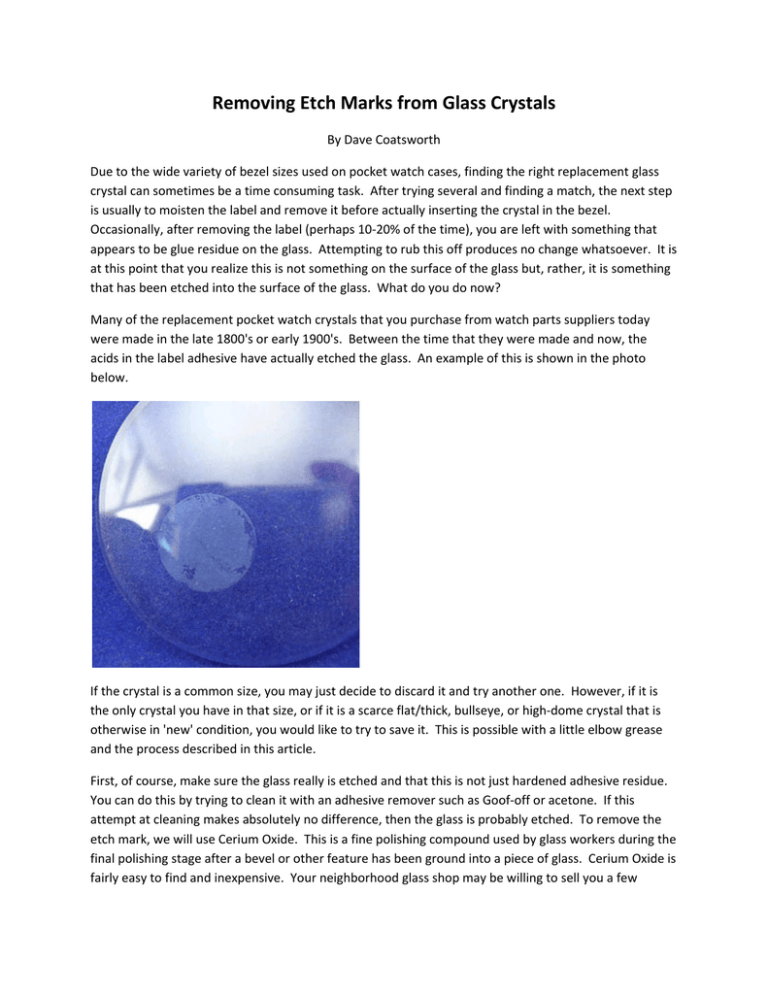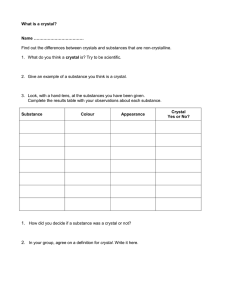Removing Etch Marks from Glass Crystals
advertisement

Removing Etch Marks from Glass Crystals By Dave Coatsworth Due to the wide variety of bezel sizes used on pocket watch cases, finding the right replacement glass crystal can sometimes be a time consuming task. After trying several and finding a match, the next step is usually to moisten the label and remove it before actually inserting the crystal in the bezel. Occasionally, after removing the label (perhaps 10‐20% of the time), you are left with something that appears to be glue residue on the glass. Attempting to rub this off produces no change whatsoever. It is at this point that you realize this is not something on the surface of the glass but, rather, it is something that has been etched into the surface of the glass. What do you do now? Many of the replacement pocket watch crystals that you purchase from watch parts suppliers today were made in the late 1800's or early 1900's. Between the time that they were made and now, the acids in the label adhesive have actually etched the glass. An example of this is shown in the photo below. If the crystal is a common size, you may just decide to discard it and try another one. However, if it is the only crystal you have in that size, or if it is a scarce flat/thick, bullseye, or high‐dome crystal that is otherwise in 'new' condition, you would like to try to save it. This is possible with a little elbow grease and the process described in this article. First, of course, make sure the glass really is etched and that this is not just hardened adhesive residue. You can do this by trying to clean it with an adhesive remover such as Goof‐off or acetone. If this attempt at cleaning makes absolutely no difference, then the glass is probably etched. To remove the etch mark, we will use Cerium Oxide. This is a fine polishing compound used by glass workers during the final polishing stage after a bevel or other feature has been ground into a piece of glass. Cerium Oxide is fairly easy to find and inexpensive. Your neighborhood glass shop may be willing to sell you a few ounces, which will be enough to save many crystals. You can also find it on eBay or at glass‐working specialty suppliers like www.hisglassworks.com. Cerium Oxide is supplied as a powder but must be mixed with water to form a slurry. You won't need very much of it, perhaps just a teaspoon. Mix the powder with a small amount of water until you have a mix with about the same consistency as pancake batter. You can apply the slurry with a cloth pad, but I have found that the best applicator is a piece of softwood dowel about 2 inches long and with a diameter of about 1 1/4 inches. The fibers of the softwood seem to hold just the right amount of the slurry and the dowel is much easier to handle than a cloth pad. Dip the end of the dowel into the slurry to coat the end as shown in the photo above. Then, with a fair amount of pressure, move the dowel in a circular motion over the etch mark. It will help to place the crystal on a surface that has some grip to it, such as a rubber or soft plastic mat, so that the crystal does not slip while you are working on it. Removing an etch mark like the one in the photo above will take about four or five minutes. When it seems that the mark has disappeared, check the surface of the crystal carefully by viewing it at different angles. At some point, the mark will seem to have disappeared when you look at the crystal straight‐on. However, when viewed at an angle, you may still see a 'ghost' of the etch mark. It is important that any trace of the etching is removed as even a slight ghost of the mark will produce a shadow against a pocket watch dial once the crystal is installed. Once you are finished, wash and dry the crystal thoroughly before installing it. The photo below shows the same crystal after polishing.

